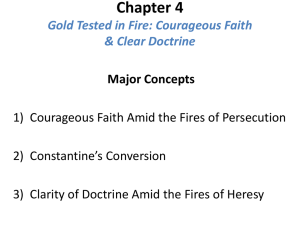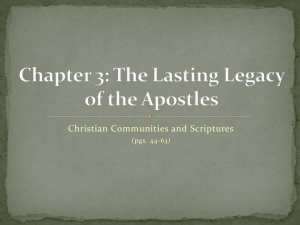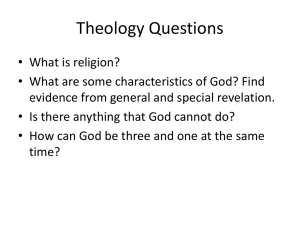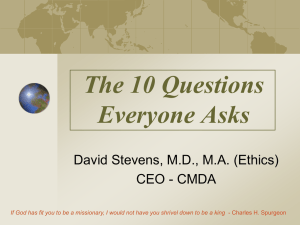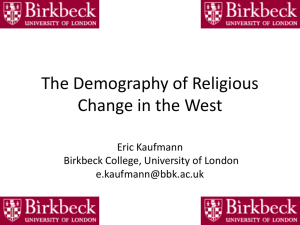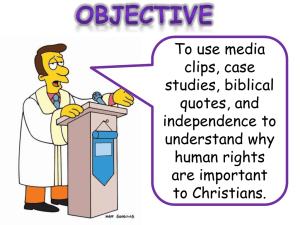Persecution of the Church
advertisement
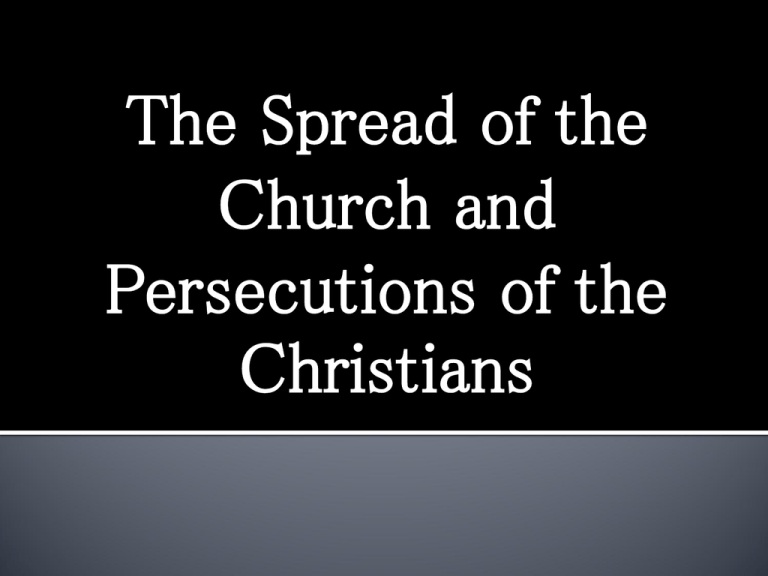
The Spread of the Church and Persecutions of the Christians 35Who will separate us from the love of Christ? Trial, or distress, or persecution, or hunger, or nakedness, or danger, or the sword? \ This letter must have been addressed to the Christians facing persecution in Rome, who were exhorted to remain firm in their faith in the Risen Lord and to withstand suffering and pain for his sake. Church Teaching: Dogmatic Constitution on the Church in the Modern World (Lumen Gentium), 8 The Church, like a pilgrim in a foreign land, presses forward amid persecution of the world and the consolations of God, announcing the cross and death of the Lord until he comes. By the power of the Risen Lord, she is given strength to overcome patiently and lovingly the afflictions and hardships which assail her from within and without and to show forth in the world the mystery of the Lord in a faithful though shadowed way, until at last it will be revealed in total splendor. The challenge… In one meaningful sentence explain the Church Teaching using these highlighted words… Church, persecution, power of the Risen Lord, strength, patiently and lovingly The Church continues the tasks of evangelization, bringing Christ and his Gospel to those who have not known him and to continually preach conversion to all for the salvation of the world Brief sketch of the persecution of the Church In the first three centuries after Christ, the church faced periods of severe persecution. Christians were ordered to sacrifice to the Roman gods; Scriptures were confiscated; some believers were beheaded or sent to work and die in the mines. During persecution, not everyone was as faithful as Perpetua and Polycarp. Some denied their faith. After a persecution ended, many of those who had denied the faith sought forgiveness and re-admittance in the church. Some church members opposed and some favored their re-admittance. At stake was the nature of the church. Was the church a society of people who obeyed Christ’s teachings or a home for forgiven sinners? We will examine the persecution early Christians faced. We’ll also look at how the church dealt with the aftermath (result, outcome). Persecution in the Early Centuries The first major outbreak of Christian persecution began with Stephen’s martyrdom around A.D. 35 Other conditions which made Christianity become widely spread were: 1) People were tired of the old pagan religions, those which required the worship of many gods and goddesses. 2) People were drawn to the teachings of Christianity; one God, selfless love and eternal deliverance. 3) Christian missionaries were free to travel and preach the religion throughout the Roman Empire. 4) The fundamental worth and dignity of the person equality was practiced: all persons are equal in their intrinsic worth and are entitled to equal rights and privileges. The dignity of women was exalted. The glorious status of the Blessed Virgin Mary as the Mother of God and the first disciple of Christ elevated the dignity of women. 5) The spirit of Christian compassion for the poor, the sick and the abandoned. Christian charity was impressive force in the care of the afflicted 6) The thirst for power and wealth was confronted by the Christian’s respect for the rights of others to the goods of the earth and by the belief in the everlasting treasures for the next life. 7) Early Christian leaders were men of courage, dedication and capability. They even face persecution courageously. Basis of persecution: Christians were accused of being atheists because, unlike their neighbors, they were “irreligious”—they refused to worship Roman deities or emperors. Christians separated themselves from the rest of the society. They were believed to engage in some form of cannibalism in their Eucharistic rites which were celebrated in secret. Christians condemned bloody games like the gladiatorial contests. Natural disasters and catastrophes were attributed to their refusal to participate in the worship of pagan gods. Christians showed disloyalty to the state by not paying the imposed temple tax. Persecution was instigated by (1) Roman officials, (2) Jewish leaders of the first century who saw Christians as heretics, and (3) sometimes by angry locals who thought Christians were odd or dangerous. Much of the time, official persecution was regional and sporadic. Under certain emperors there were long periods of tolerance. Some emperors, however, led systematic and at times empire-wide persecution of Christians, trying to exterminate this “illicit” sect. Group reporting of the ROMAN EMPERORS Group 1: Emperor Nero and Domitian Group 2: Emperor Trajan and Hadrian Group 3: Emperor Antonius Pius and Marcus Aurelius Group 4: Septimus Severus and Decius Group 5: Emperor Valerian and Diocletian Group 6: Emperor Galerius and Maximinus Daia Group 7: Emperor Constantine and Theodosius Questions: When did he reign, and how did he die? On what basis did he persecute the Christians? How did Christians respond, and who were notable Christians or martyrs under his reign? Persecution: Refers to afflictions imposed on people by their own fellow beings especially those who differ in origin, religion, or social outlook with intention to injure or distress. Claudius Nero was named emperor at age 16 and reigned from A.D. 54-68. He had about five good years under the guidance of Seneca, the Roman poet and philosopher. He had his mother killed in A.D. 59 He had his wife killed in 64 AD He later killed a brother and his teacher, Seneca. He accused the Christians of burning Rome in 64 A.D. and ordered their execution. A narrative account of TACITUS, the greatest Roman historian, included the rumor that Nero himself was responsible for the fire to gain the glory of rebuilding the city. The Christians were persecuted and turned into living torches in the garden of Nero. They became the object of his fury/anger following the Great Fire of Rome in A.D. 64. . Martyrs: Peter and Paul Was a bad emperor whose rule was marked by cruel severity. Like Nero, he persecuted the Christians. One of his victims was his own niece Domitilla, a pretty Christian maid. Because of his cruelty, he was murdered in his palace and the senate ordered that his men be cursed and his name stricken from all public monuments. Martyrs: Clement of Rome and John (exiled to Patmos) Emperor Trajan ruled from A.D. 98-117 He began sentencing Christians who refused to honor the gods and the emperor to death In 107 he went to Antioch and demanded that everyone should give sacrifices to the gods. Martyr: Ignatius, Bishop of Antioch and pupil of the apostle John, refused and was martyred by being thrown to wild animals. EMPEROR HADRIAN (II7-138) He issued a decree that governors should not follow the desires of the mob. Christians who were accused of a crime must be judged according to the nature of their crimes. The decree gave some relief to the suffering Christians Martyr: Telesphorus Antonius Pius He accused the ruled from A.D. 138- Christians of being 161 ATHEIST (one who denies the existence god) for not worshipping the emperor. During Antonius' reign, Polycarp, an 86 year old man, a pupil of the apostle John, was martyred in Asia that took place in the year 156. In A.D. 161 Marcus Aurelius took power and reigned until 180. He didn’t directly lead persecutions against Christians. He had no sympathy for them because he saw them as being disgustingly superstitious. For Aurelius, it was good to die for something significant, but not for something as silly as what the Christians believed He regarded the Christians as a threat to the state. His successors started empire-wide actions on the Christians. Bent on eradicating Christianity completely. This gave rise to a systematic and cruel persecution of Christians throughout the empire. MARTYRS: Justin, the Philosopher and the martyrs of Lyon, Blandina. Septimus Severus who ruled from 193-211 -allowed the enforcement of policies already long-established, which meant that Roman authorities did not intentionally seek out Christians, but when people were accused of being Christians they could either curse Jesus and make an offering to Roman gods, or be executed "Many martyrs are daily burned, confined, or beheaded, before our eyes.” -Clement of Alexandria Clement is counted as one of the early Church Fathers Martyrs: Leonides, the father of Origen, a Christian defender, was beheaded • Perpetua, a young noblewoman, and • Felicitas, a slave girl, held hands and exchanged a kiss before being thrown to wild animals at a public festival. Emperor Decius (249-251). He saw Christianity as a terrible poison. He ordered that all Christians must make a public act of homage to the Roman gods. His role was to eradicate Christianity completely. Martyrs: Fabianus, Alexander of Jerusalem Emperor Valerian (257 AD). He decreed that all bishops, presbyters and deacons were to offer sacrifice to gods. MARTYRS Cyprian of Carthage Pope Sixtus II of Rome Origen Emperor Diocletian (284-305 AD) The last and bloodiest persecution. He decreed that all Christians churches be destroyed and bibles burned. He divided Roman Empire into a tetrarchy Martyrs: Mauricius & Alban EMPEROR GALERIUS •The persecution of the Christians only came to end when Galerius admitted their uselessness •He realized that the persecutions only made the Christians more firm in their faith and attracted more pagans top become Christians. •He issued the Edict of Tolerance-granting Christianity the right to exist. MAXIMINUS DAIA Once again demanded Christian blood. But suddenly ordered persecutions to cease. ..because the pressure to stop had been put on Maximinus by the new conqueror of Italy and Africa, who was now the sole master of the Western world. Constantine The persecution of Christians ended in 313 when Constantine of the West proclaimed the Edict of Milan, which established a policy of religious freedom for all. On his way to fight against a rival emperor, Galerius, he saw in the sky a flaming cross with the inscribed words: “ In hoc signo vinces”(in this sign, you shall conquer) He used a cross and won over his rival. In gratitude, he issued Edict of Milan-granted the religious tolerance of Christians. He himself became a convert to Christianity. THEODOSIUS During his reign, worship of old gods was declared illegal and Christianity was encouraged. Thus after 3 centuries of persecution, Christianity became the religion of the Roman Empire Guide Questions Have you ever been misjudged, disliked, or mistreated because of your faith? How did you respond? In what ways are Christians today pressured to compromise their faith? Some Christians (for example, Clement of Alexandria) fled persecution, while others (such as Ignatius of Antioch) seemed to look forward to martyrdom. What reasons might people give for avoiding or embracing martyrdom? What does it mean to rejoice in persecution? (See Matthew 5:11-12; Colossians 1:24; James 1:1-18; and 1 Peter 4:12-19.) Which beliefs of the early Christians, such as those of Perpetua, helped them withstand persecution and accept martyrdom? To what degree do Christians today hold those beliefs? Why What reasons did Roman authorities use to justify persecuting the Christians? What reasons does our culture give for the mistreatment of religious or ethnic minorities? Is it possible to be a faithful Christian and not experience persecution? The persecutions involved— a. confiscation of property b. banishment (expulsion, exile) c. imprisonment d. labor in the mines e. torture f. execution by fire and wild beasts g. Roman citizens were executed by the sword. The responses of Christians to the persecution earned them the following designations: a. “Martyrs”: those who died for their faith. They were honored and eventually venerated by the church. (The Greek word martyr means “witness.”) b. “Confessors”: those who stood firm under torture and imprisonment but were not killed. c. “Avoiders”: those who went into hiding. d. “Lapsed”: those who renounced Christ while under persecution and sacrificed to Roman gods. The Church during and after the Period of Persecution 1. MARTYRDOM for Christ was a driving force that urged people to face death fearlessly. -Total self-giving 2. Liturgy and creed of the Church was developed 3. Central of Christian worship is the Eucharist 4. Wednesdays and Fridays were days of fasting 5. Easter the central feast day celebrated on a Sunday 6. The Sacrament of Baptism was celebrated with a complete immersion 7. Veneration of the saints developed 8. The Christians celebrated the feast of the martyrs – catacombs The catacombs are the ancient underground cemeteries, used by the Christian and the Jewish communities, above all at Rome. During the persecutions, in exceptional cases, the catacombs were used as places of momentary refuge for the celebration of the Eucharist After the persecutions they became real shrines of the martyrs, centers of devotion and of pilgrimage for Christians from every part of the empire 9. Use of arts and symbols 10. Christian signs and symbols were carved on the walls of the tombs of the martyrs Persecution of the Church lasted for more than three hundred years Christian Symbols A to Z (SEE PPT 2) THE DISSENSIONS WITHIN THE CHURCH The newly acquired freedom and recognition of Christianity led to the extension of its boundaries and growth in the number of converts. But Christianity grew, certain controversies regarding the mysteries of the Trinity and the Incarnation of Christ arose within the Church. These controversies gave rise to false teachings or beliefs contrary to the revealed truths of the Catholic faith. The false teachings are referred to as HERESIES (caused confusion and dissension among Christians) So the Church convened several ecumenical councils to take firm position against heresies. ECUMENICAL COUNCILS It refers to general meetings of the Church in which important matters of faith and Christian living are discussed. These are the better-known heresies and the ecumenical councils convened against them. HERESY ECUMENICAL COUNCIL AND YEAR st Ecumenical Council in 1 Arianism Nicaea (AD 325) assembled Heresy: Arius-founder, in Constantinople. taught that Christ being a It condemned Arianism as a Son of God was not fully heresy and adopted the divine as God the Father. Nicaean Creed which St. Athanasius defended confirms the divinity of that Christ, the Son of Christ. In AD 381, the 2nd God was as divine as God Ecumenical Council in the Father. Constantinople condemned Arianism HERESY Nestorianism Heresy: Its founder, Nestorious, a patriarch of Constantinople denied the real unity of the divine and human natures in the Divine Person of Christ. He also taught that Mary was only the mother of Christ, the human person; hence she was not the mother of God. ECUMENICAL COUNCIL AND YEAR This doctrine of Nestorious was condemned by the Third Ecumenical Council in Ephesus in AD 431. HERESY ECUMENICAL COUNCIL AND YEAR Pope Leo I denounced it. The 4th Heresy: claimed that Ecumenical Christ has only one Council in nature: the divine Chalcedon in AD 451 condemned it. Monophysitism The heresies did not die easily. During the same period, many churchmen noted for their intellectual gifts and saintly virtues became famous as brilliant defenders of Christian Faith. The Church honored them by conferring on them the title of “CHURCH FATHER” or “DOCTORS OF THE CHURCH.” The outstanding Doctors of the Church St. Jerome-translated the Bible into Latin St. Athanasius- fought Arianism and defended the Holy Trinity St. Ambrose of Milan-defended the Church liberties against Emperor Valentinian II St. John Chrysostom-denounced Monophysitism St. Augustine, Bishop of Hippo, who was the greatest of all Church Fathers - became the foremost defender of the Church against all heretics. St. Augustine of Canterbury-carried out Evangelization in England as envisioned by Pope St. Gregory the Great. -He became the first Archbishop of England Lumen Gentium 8 •The Church is the living sign of Christ’s presence in the world •In her effort to fulfill the mission- the Church withstand the great suffering and persecution in the hands of those who reject the message of the gospel The apostle Paul noted in (Phil. 1:14). Through all the terrible persecutions of the early centuries the church continued to grow. Are we prepared to truly suffer for our faith? Are ready to defend your faith? Answer the ff: Why were the early Christians persecuted severely? What is the effect of persecution on the early Christians and on the whole Church? What problem arose as the number of Christians increased after the persecution of the Church? How did the Church face this problem? Lord God, If persecution ever comes, God grant us the faithfulness to stand firm. And let’s not forget to pray and work to help our brothers and sisters who are suffering for the name of Jesus Christ. Amen. Sw#1: 20 points SECOND GRADING 5 points each by pair 1. What made the early Christians ever more firm and alive in their faith and their number increased despite persecution? Explain. 2. In our contemporary times, there are many people in our society who are classified as “Modern Lapsed” (those who renounced Christ while under persecution). What can you do to help them remain firm and faithful to Christ? Cite concrete actions. 3. Jesus Himself experienced humiliation, insult, persecutions, and trials from people. Write a prayer of thanksgiving for Jesus’ sacrifices because of His love for you, as you yourself up from you own pains and sufferings. 4. Are we prepared to truly suffer for our faith? Are ready to defend your faith? If yes, in what way? Or how will you defend it? If not yet, what will you do in order to stand firm with your faith?
